
Bukhara is the seventh-largest city in Uzbekistan by population, with 280,187 residents as of 1 January 2020. It is the capital of Bukhara Region.

Architecture of Central Asia refers to the architectural styles of the numerous societies that have occupied Central Asia throughout history. These styles include a regional tradition of Islamic and Iranian architecture, including Timurid architecture of the 14th and 15th centuries, as well as 20th-century Soviet Modernism. Central Asia is an area that encompasses land from the Xinjiang Province of China in the East to the Caspian Sea in the West. The region is made up of the countries of Kazakhstan, Uzbekistan, Tajikistan, Kyrgyzstan, and Turkmenistan. The influence of Timurid architecture can be recognised in numerous sites in Kazakhstan and Uzbekistan, whilst the influence of Persian architecture is seen frequently in Uzbekistan and in some examples in Turkmenistan. Examples of Soviet architecture can be found in Uzbekistan, Kazakhstan, Tajikistan and Kyrgyzstan.
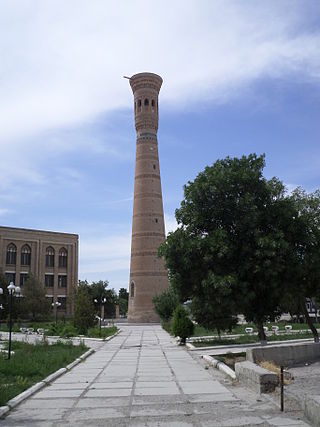
Vobkent is a city in the Bukhara Region of Uzbekistan and the capital of Vobkent District. It is famous for a minaret constructed in 1196–1198, under the reign of Ala ad-Din Tekish.

The Kalyan Minaret is a minaret of the Po-i-Kalyan mosque complex in Bukhara, Uzbekistan and one of the most prominent landmarks in the city.
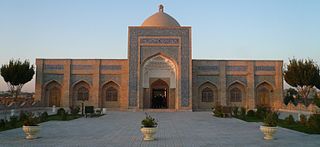
Bahoutdin Architectural Complex is a complex in Bukhara, Uzbekistan, that includes the tomb of Baha-ud-Din Naqshband Bukhari, the founder of the Naqshbandi order, who died in 1389. The ancient name of the location was Kasri Arifon.

Chor-Bakr is a memorial complex in the village of Sumitan at 5 km of Bukhara in Uzbekistan, built over the burial place of Abu-Bakr-Said, who died in the year 360 of the Muslim Calendar, and who was one of the four of Abu-Bakrs (Chor-Bakr) – descendants of Muhammad. The complex includes the necropolis of family tombs, and courtyards enclosed with walls.

Chashma-Ayub Mausoleum is located near the Samani Mausoleum, in Bukhara, Uzbekistan. Its name means Job's well, due to the legend in which Job (Ayub) visited this place and made a well by striking the ground with his staff. The water of this well is still pure and is considered healing. The current building was constructed during the reign of Timur and features a Khwarazm-style conical dome uncommon in Bukhara.
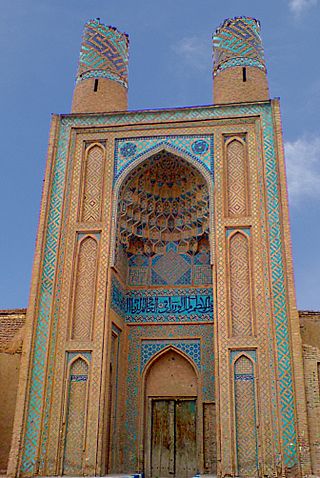
Jameh Mosque of Ashtarjan is a mosque in Ashtarjan, Iran, located 36 kilometers south-west of Isfahan.

In Iranian architecture, banna'i is an architectural decorative art in which glazed tiles are alternated with plain bricks to create geometric patterns over the surface of a wall or to spell out sacred names or pious phrases. This technique originated in Syria and Iraq in the 8th century, and matured in the Seljuq and Timurid era, as it spread to Iran, Anatolia and Central Asia.
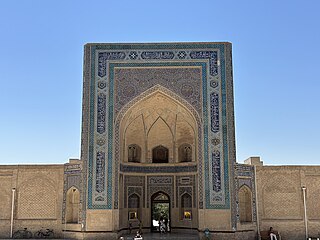
Kalan Mosque is an architectural monument located in Bukhara, Uzbekistan. It was considered one of the largest mosques built on the place of Jame' Mosque. Its current appearance was built in 1514 during the reign of Shaybani Ubaidullah Khan of Bukhara. Currently, the mosque is included in the national list of estate real objects of material and cultural heritage of Uzbekistan.

Abu Hafs Kabir Bukhari Memorial Complex is an architectural monument located in Bukhara. The complex consists of Abu Hafs Kabir Bukhari Mausoleum, Hazrat Imam's cemetery, a mosque, a minaret, a pool and a shrine. The mausoleum is included in the national list of real estate objects of the material and cultural heritage of Uzbekistan.

Khoja Abdulkhalik Gijduvani Complex is an architectural monument in the city of Gijduvan, Bukhara Region. The complex is located 50 km from the city of Bukhara and was built by Abdukholiq ibn Abdujalil Gijduvani, the founder of the Khojagan sect. The complex consists of the mausoleum of Khoja Abdulkhaliq Gijduvani, the Ulugbek Madrasah, a mosque and a pool. Khoja Abdulkhaliq Gijduvani is the first representative of seven pirs in Bukhara. He became known as Khojai Jahan and founded the school of Sufism. In 1433, Timurid Mirza Ulugbek built a madrasa in front of the shrine of Khoja Abdulkhaliq Gijduvani. In 2003, the 900th anniversary of Khoja Abdulkhaliq Gijduvani was widely celebrated. The Ulugbek madrasah in the complex was distinguished by its appearance. A mosque was built in this complex during the reign of Shaibani Ubaydullah Khan of Bukhara (1539–1550). In 1583, the madrasa and mosque were renovated during the reign of Bukhara Khan Abdullah Khan II (1583–1598). Verses 1–7 of Surah Alaq were mentioned on the facade of the Mirzo Ulugbek madrasah. These notes were written in suls script. However, most of them have collapsed. In 1946, certain part of the Mirzo Ulugbek madrasa records were read and accordingly it was restored. The tombstone of Abdukholiq Gijduvani was made of stone and the eleventh verse of Surah "Mujodala" from the Quran was written on the sides. On the short sides of the tombstone, an epitaph was written. The mosque in the complex of Khoja Abdulkhaliq Gijduvani was rebuilt in 2003. Nowadays, all the conditions for pilgrims have been created in the complex of Khoja Abdulkhaliq Gijduvani.
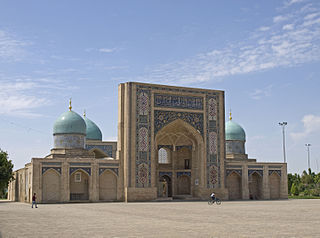
The Hazrati Imam complex is an architectural monument dating from the 16th to 20th centuries, located in the Olmazor district of Tashkent city, Uzbekistan. The complex consists of the Moʻyi Muborak madrasa, the Qaffol Shoshi mausoleum, the Baroqxon Madrasa, the Hazrati Imam mosque, the Tillashayx mosque, and the Imam al-Bukhari Islamic Institute. The ensemble was built near the grave of Hazrati Imam, the first imam-khatib of Tashkent, a scholar, one of the first Islamic preachers in Tashkent, a poet and an artist.

Nodir Devonbegi is a historical memorial in Bukhara, Uzbekistan. It was established by Nodir Devonbegi, the vizier and brother of the ruler of Bukhara, Imamquli Khan, in 1620–1621. The khanqah has been included in the national list of intangible cultural heritage objects of Uzbekistan. It is a type of building that served as a place of residence and worship for Sufi mystics.

The Bukhara Mosque is a historical monument in Bukhara. It is one of the mosques built for praying during Eid festivals. It was built behind the gate of the prayer hall in the southern part of Bukhara by Shams al-Mulk (1068-1080), who ruled Bukhara under the Kara-Khanid dynasty, in the 11th century. It was built in the 11th-16th centuries.

Kasri Orifon Minaret is a minaret in Bahoutdin Architectural Complex, Kasri Orifon village, Bukhara Khanate, Kogon District.

Ulugbek Madrasah is a memorial to Abdul Khaliq Ghijduwani, located in the city of Gijduvon in the Bukhara region of Uzbekistan. It is one of the ancient and renowned madrasas of Bukhara, also known as the "Fayziya Madrasah." Presently, it is also referred to as the Mirzo Ulugbek Madrasa. This prestigious educational institution was built in the Hijri year 836 beside the grave of Shaykh Abdul Khaliq Ghijduwani, with a two-story structure made of baked bricks. The Ulugbek Madrasah, established by Ulugh Beg, is the third and last madrasa he founded, relatively smaller and simpler compared to the Ulugbek Madrasah in Bukhara and Samarkand.

Modarikhan Madrasah is an architectural monument (1566-1567) located opposite the Abdullah Khan Madrasah in Bukhara. Both make up the Koshmadrasa complex. Abdullakhan Madrasah (Bukhara) is located opposite. Currently, it is included in the national list of real estate objects of material and cultural heritage of Uzbekistan.39.77447717366°N 64.40592327683°E

Nadir Devanbegi Madrasah is an architectural monument in Bukhara, Uzbekistan. It was built between 1622 and 1623 by Nadir Devanbegi, the minister of Bukhara Khan, Imam Quli Khan. Nadir Devonbegi madrasah is located in the old city of Bukhara. It is located in the eastern part of the Lyab-i Hauz. Currently, the madrasah is included in the national list of immovable property objects of the material and cultural heritage of Uzbekistan.
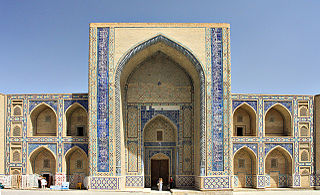
Ulugbek madrasah is an architectural monument (1417) in Bukhara, Uzbekistan. It is the oldest preserved madrasah in Central Asia. It is the oldest of the madrasahs built by Ulugbek. During the reign of Abdullah Khan II, major renovation works were carried out (1586).






















